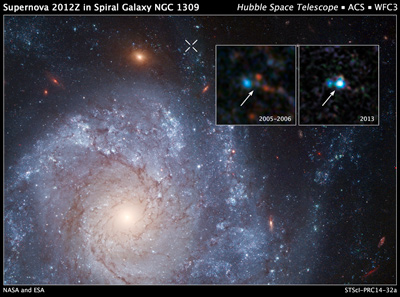
Astronomers using NASA's Hubble Space Telescope for the first time have spotted a star system that later produced an unusual supernova explosion of a white dwarf, the stripped-down core of an ordinary star at the end of its life. Examining archived Hubble images taken before the supernova, astronomers say they have detected the blue companion star of the white dwarf. The white dwarf slowly siphoned fuel from its companion, eventually igniting a runaway nuclear reaction in the dead star, and producing a weak supernova blast. This particular supernova is classified as a Type Iax, a recently identified class of stellar explosion. These exploding stars are less energetic and fainter than Type Ia supernovae, which also originate from exploding white dwarfs in binary systems. Astronomers originally thought these weaker stellar blasts were unique Type Ia supernovae. So far, they have identified more than 30 of these mini-explosions, which occur at one-fifth the rate of Type Ia supernovae. "Astronomers have been searching for decades for the progenitors of Type Ia's," said Saurabh Jha of Rutgers University in Piscataway, New Jersey. "Type Ia's are important because they're used to measure vast cosmic distances and the expansion of the universe. But we have very few constraints on how any white dwarf explodes. The similarities between Type Iax's and normal Type Ia's make understanding Type Iax progenitors important, especially because no Type Ia progenitor has been conclusively identified. This discovery shows us one way that you can get a white dwarf explosion." For a little more insight into the project see this:http://hubblesite.org/newscenter/archive/releases/2014/32/full/ |
